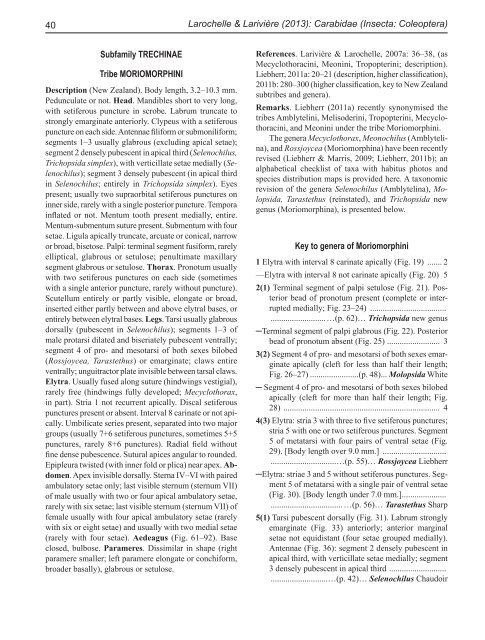Fauna of New Zealand 69 - Landcare Research
Fauna of New Zealand 69 - Landcare Research
Fauna of New Zealand 69 - Landcare Research
Create successful ePaper yourself
Turn your PDF publications into a flip-book with our unique Google optimized e-Paper software.
40<br />
Subfamily TRECHINAE<br />
Tribe MORIOMORPHINI<br />
Description (<strong>New</strong> <strong>Zealand</strong>). Body length, 3.2–10.3 mm.<br />
Pedunculate or not. Head. Mandibles short to very long,<br />
with setiferous puncture in scrobe. Labrum truncate to<br />
strongly emarginate anteriorly. Clypeus with a setiferous<br />
puncture on each side. Antennae filiform or submoniliform;<br />
segments 1–3 usually glabrous (excluding apical setae);<br />
segment 2 densely pubescent in apical third (Selenochilus,<br />
Trichopsida simplex), with verticillate setae medially (Selenochilus);<br />
segment 3 densely pubescent (in apical third<br />
in Selenochilus; entirely in Trichopsida simplex). Eyes<br />
present; usually two supraorbital setiferous punctures on<br />
inner side, rarely with a single posterior puncture. Tempora<br />
inflated or not. Mentum tooth present medially, entire.<br />
Mentum-submentum suture present. Submentum with four<br />
setae. Ligula apically truncate, arcuate or conical, narrow<br />
or broad, bisetose. Palpi: terminal segment fusiform, rarely<br />
elliptical, glabrous or setulose; penultimate maxillary<br />
segment glabrous or setulose. Thorax. Pronotum usually<br />
with two setiferous punctures on each side (sometimes<br />
with a single anterior puncture, rarely without puncture).<br />
Scutellum entirely or partly visible, elongate or broad,<br />
inserted either partly between and above elytral bases, or<br />
entirely between elytral bases. Legs. Tarsi usually glabrous<br />
dorsally (pubescent in Selenochilus); segments 1–3 <strong>of</strong><br />
male protarsi dilated and biseriately pubescent ventrally;<br />
segment 4 <strong>of</strong> pro- and mesotarsi <strong>of</strong> both sexes bilobed<br />
(Rossjoycea, Tarastethus) or emarginate; claws entire<br />
ventrally; unguitractor plate invisible between tarsal claws.<br />
Elytra. Usually fused along suture (hindwings vestigial),<br />
rarely free (hindwings fully developed; Mecyclothorax,<br />
in part). Stria 1 not recurrent apically. Discal setiferous<br />
punctures present or absent. Interval 8 carinate or not apically.<br />
Umbilicate series present, separated into two major<br />
groups (usually 7+6 setiferous punctures, sometimes 5+5<br />
punctures, rarely 8+6 punctures). Radial field without<br />
fine dense pubescence. Sutural apices angular to rounded.<br />
Epipleura twisted (with inner fold or plica) near apex. Abdomen.<br />
Apex invisible dorsally. Sterna IV–VI with paired<br />
ambulatory setae only; last visible sternum (sternum VII)<br />
<strong>of</strong> male usually with two or four apical ambulatory setae,<br />
rarely with six setae; last visible sternum (sternum VII) <strong>of</strong><br />
female usually with four apical ambulatory setae (rarely<br />
with six or eight setae) and usually with two medial setae<br />
(rarely with four setae). Aedeagus (Fig. 61–92). Base<br />
closed, bulbose. Parameres. Dissimilar in shape (right<br />
paramere smaller; left paramere elongate or conchiform,<br />
broader basally), glabrous or setulose.<br />
Larochelle & Larivière (2013): Carabidae (Insecta: Coleoptera)<br />
References. Larivière & Larochelle, 2007a: 36–38, (as<br />
Mecyclothoracini, Meonini, Tropopterini; description).<br />
Liebherr, 2011a: 20–21 (description, higher classification),<br />
2011b: 280–300 (higher classification, key to <strong>New</strong> <strong>Zealand</strong><br />
subtribes and genera).<br />
Remarks. Liebherr (2011a) recently synonymised the<br />
tribes Amblytelini, Melisoderini, Tropopterini, Mecyclothoracini,<br />
and Meonini under the tribe Moriomorphini.<br />
The genera Mecyclothorax, Meonochilus (Amblytelina),<br />
and Rossjoycea (Moriomorphina) have been recently<br />
revised (Liebherr & Marris, 2009; Liebherr, 2011b); an<br />
alphabetical checklist <strong>of</strong> taxa with habitus photos and<br />
species distribution maps is provided here. A taxonomic<br />
revision <strong>of</strong> the genera Selenochilus (Amblytelina), Molopsida,<br />
Tarastethus (reinstated), and Trichopsida new<br />
genus (Moriomorphina), is presented below.<br />
Key to genera <strong>of</strong> Moriomorphini<br />
1 Elytra with interval 8 carinate apically (Fig. 19) ....... 2<br />
—Elytra with interval 8 not carinate apically (Fig. 20) 5<br />
2(1) Terminal segment <strong>of</strong> palpi setulose (Fig. 21). Posterior<br />
bead <strong>of</strong> pronotum present (complete or interrupted<br />
medially; Fig. 23–24) ....................................<br />
..........................…(p. 62)… Trichopsida new genus<br />
─Terminal segment <strong>of</strong> palpi glabrous (Fig. 22). Posterior<br />
bead <strong>of</strong> pronotum absent (Fig. 25) ......................... 3<br />
3(2) Segment 4 <strong>of</strong> pro- and mesotarsi <strong>of</strong> both sexes emarginate<br />
apically (cleft for less than half their length;<br />
Fig. 26–27) .......................(p. 48)... Molopsida White<br />
─ Segment 4 <strong>of</strong> pro- and mesotarsi <strong>of</strong> both sexes bilobed<br />
apically (cleft for more than half their length; Fig.<br />
28) .......................................................................... 4<br />
4(3) Elytra: stria 3 with three to five setiferous punctures;<br />
stria 5 with one or two setiferous punctures. Segment<br />
5 <strong>of</strong> metatarsi with four pairs <strong>of</strong> ventral setae (Fig.<br />
29). [Body length over 9.0 mm.] ..............................<br />
...............................…(p. 55)… Rossjoycea Liebherr<br />
─Elytra: striae 3 and 5 without setiferous punctures. Segment<br />
5 <strong>of</strong> metatarsi with a single pair <strong>of</strong> ventral setae<br />
(Fig. 30). [Body length under 7.0 mm.] .....................<br />
.................................. …(p. 56)… Tarastethus Sharp<br />
5(1) Tarsi pubescent dorsally (Fig. 31). Labrum strongly<br />
emarginate (Fig. 33) anteriorly; anterior marginal<br />
setae not equidistant (four setae grouped medially).<br />
Antennae (Fig. 36): segment 2 densely pubescent in<br />
apical third, with verticillate setae medially; segment<br />
3 densely pubescent in apical third ...........................<br />
...........................…(p. 42)… Selenochilus Chaudoir
















